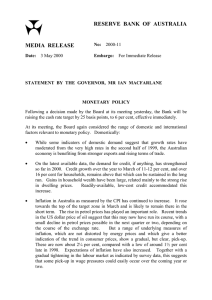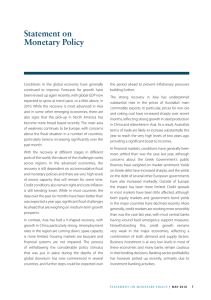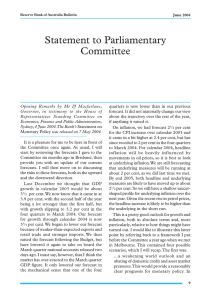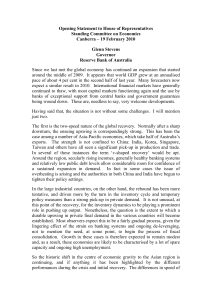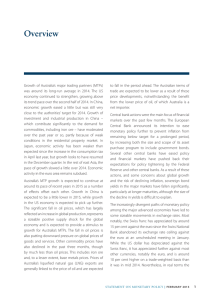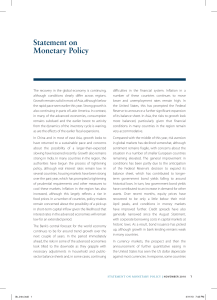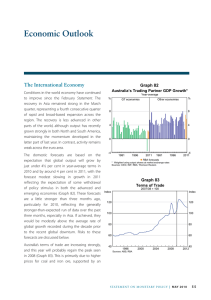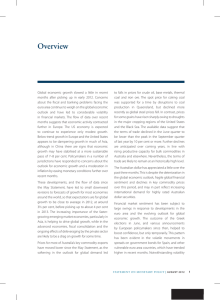Statement on Monetary Policy
advertisement
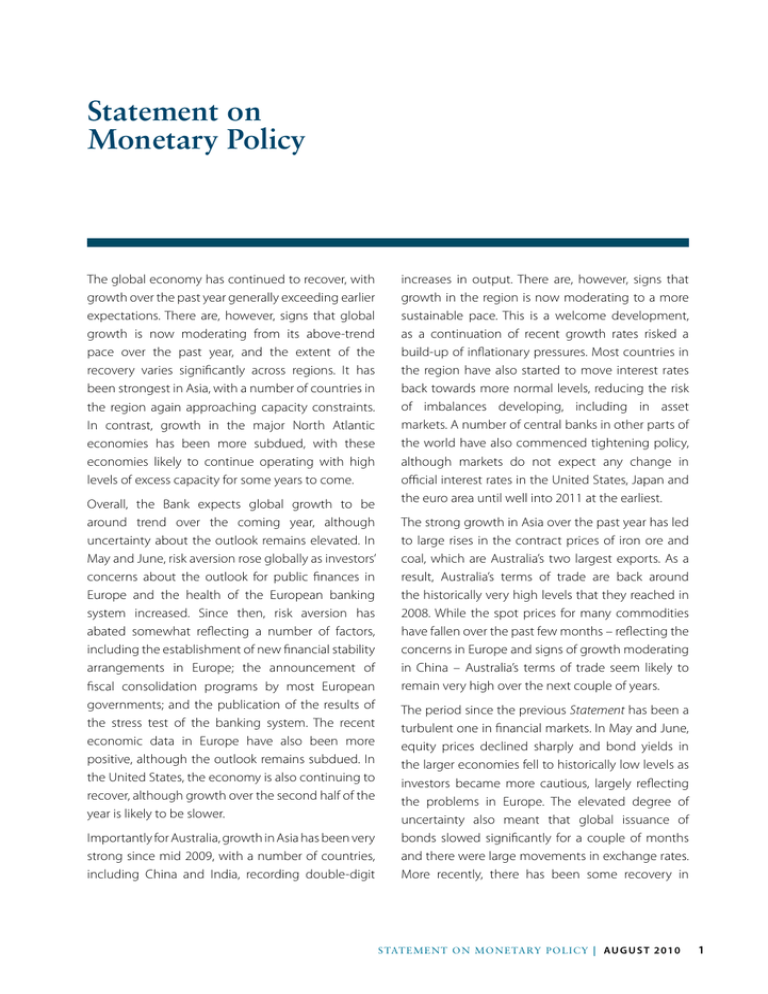
Statement on Monetary Policy The global economy has continued to recover, with growth over the past year generally exceeding earlier expectations. There are, however, signs that global growth is now moderating from its above-trend pace over the past year, and the extent of the recovery varies significantly across regions. It has been strongest in Asia, with a number of countries in the region again approaching capacity constraints. In contrast, growth in the major North Atlantic economies has been more subdued, with these economies likely to continue operating with high levels of excess capacity for some years to come. Overall, the Bank expects global growth to be around trend over the coming year, although uncertainty about the outlook remains elevated. In May and June, risk aversion rose globally as investors’ concerns about the outlook for public finances in Europe and the health of the European banking system increased. Since then, risk aversion has abated somewhat reflecting a number of factors, including the establishment of new financial stability arrangements in Europe; the announcement of fiscal consolidation programs by most European governments; and the publication of the results of the stress test of the banking system. The recent economic data in Europe have also been more positive, although the outlook remains subdued. In the United States, the economy is also continuing to recover, although growth over the second half of the year is likely to be slower. Importantly for Australia, growth in Asia has been very strong since mid 2009, with a number of countries, including China and India, recording double-digit increases in output. There are, however, signs that growth in the region is now moderating to a more sustainable pace. This is a welcome development, as a continuation of recent growth rates risked a build-up of inflationary pressures. Most countries in the region have also started to move interest rates back towards more normal levels, reducing the risk of imbalances developing, including in asset markets. A number of central banks in other parts of the world have also commenced tightening policy, although markets do not expect any change in official interest rates in the United States, Japan and the euro area until well into 2011 at the earliest. The strong growth in Asia over the past year has led to large rises in the contract prices of iron ore and coal, which are Australia’s two largest exports. As a result, Australia’s terms of trade are back around the historically very high levels that they reached in 2008. While the spot prices for many commodities have fallen over the past few months – reflecting the concerns in Europe and signs of growth moderating in China – Australia’s terms of trade seem likely to remain very high over the next couple of years. The period since the previous Statement has been a turbulent one in financial markets. In May and June, equity prices declined sharply and bond yields in the larger economies fell to historically low levels as investors became more cautious, largely reflecting the problems in Europe. The elevated degree of uncertainty also meant that global issuance of bonds slowed significantly for a couple of months and there were large movements in exchange rates. More recently, there has been some recovery in S tate me n t o n Mo n e tary P o l icy | AU G U S T 2010 1 equity markets and a reversal of much of the earlier movement in exchange rates, although volatility in financial markets remains high. The Australian financial system remains in sound shape and loan losses appear to have peaked. During May and June, there was a notable decline in bank bond issuance, consistent with developments in global markets, although more recently, as conditions have improved, issuance has again picked up with the banks retaining ready access to both domestic and foreign markets. Over the past month or so the securitisation market has also shown further signs of improvement. While there has been a rise in credit spreads on banks’ longer-term debt, the effect of this on overall funding costs is modest. The recent data suggest that the Australian economy has been growing at around its average pace due, in part, to a strong contribution from public investment. Over the period ahead, public investment is set to decline as the various stimulus projects are completed, but a strengthening in private demand, particularly business investment, is expected. The positive outlook for investment is underpinned by Australia’s high terms of trade and the expected strong growth in Asia’s demand for energy and resources over coming years. Reflecting this, investment in the mining sector, which is already at high levels, is expected to increase further, particularly in the LNG and iron ore sectors. Survey-based measures of capacity utilisation and business conditions are at, or slightly above, average levels and corporate balance sheets are generally in sound shape. In contrast, business credit growth remains subdued and credit conditions are still difficult for some firms, particularly small businesses and those in the property industry, with commercial construction at quite low levels. Consumption expenditure has recorded modest growth over the past year. Many households are continuing to take a more cautious approach to their finances, and the household saving rate is higher than it has been over much of the past decade. This 2 R es erv e ba nk o f Aus t ra l i a caution is particularly evident in retail spending, which has been relatively subdued since mid 2009 after the earlier boost from the stimulus payments. Other forms of household spending – most notably on motor vehicles and a range of services – have been stronger over the first half of the year. Measures of consumer sentiment also remain above average and household wealth has risen by around 20 per cent over the past year, although it was flat in the June quarter. Conditions in the established housing market look to have stabilised recently. Most nationwide measures of housing prices have levelled out over the past few months after the earlier strong increases, and auction clearance rates have declined significantly to around average levels. Loan approvals to owner-occupiers have also trended lower, although investor approvals have increased, and housing credit growth has slowed recently. This moderation in the established housing market is a welcome development and partly reflects the return of mortgage rates to around average levels. In terms of new dwellings, the rate of growth in the dwelling stock remains low relative to the growth in the population. The labour market has continued to firm, with the unemployment rate standing at 5.1 per cent in June, down by ¾ percentage point from its level in mid 2009. Average hours worked also appear to be picking up although they remain significantly below the levels recorded in 2008, when the labour market was very strong. Over the past year, most industries have recorded an increase in employment, with growth fastest in the mining and business services industries. Reflecting the strength in employment, measures of private-sector wage growth have also picked up somewhat recently after the marked slowing last year. The various forward-looking indicators continue to suggest solid growth in employment over the period ahead. Year-ended underlying inflation has moderated in line with the Bank’s expectations, and at 2¾ per cent is now back in the 2–3 per cent range for the first time since September 2007. Consumer Price Index (CPI) inflation, however, was just above 3 per cent over the latest four quarters, largely due to the effect of the higher tobacco excise. The decline in underlying inflation reflects the weaker demand growth in 2008 and the first half of 2009, the lower wage increases in 2009 and the appreciation of the exchange rate. Recently, there has also been significant discounting by many retailers in response to subdued sales growth. Working in the other direction, there have been large increases in the prices of a range of utilities over the past year. The Bank’s central forecasts for output and inflation in the period ahead are largely unchanged from those published in May. The central forecast is for GDP growth of around 3¼ per cent over 2010 and 3¾–4 per cent over 2011 and 2012. This forecast is underpinned by the positive prospects for investment, particularly in the resources sector. Over the period ahead, strong growth in resource exports and a gradual pick-up in business investment is expected to offset the scaling back in public demand as stimulus-related projects are completed. In this central scenario, the economy is likely to be pushing up against supply-side constraints over time, although conditions are expected to vary across industries, with the resource-related sectors stronger than other parts of the economy. This central scenario also assumes that the household saving rate increases a little further, and that more of the boost to national income from the rise in the terms of trade is saved than was the case in the boom a few years ago. The central forecast for underlying inflation is around 2¾ per cent over the next year or so, similar to its current rate. CPI inflation is, however, likely to be above 3 per cent for the next year due to the increase in the tobacco excise and large increases in the prices of utilities. Beyond the next year, underlying inflation is expected to gradually increase to around 3 per cent in 2012, reflecting capacity pressures in parts of the economy. As always, these central forecasts are subject to a range of risks. On the downside, the main domestic risk is that the forecast pick-up in private demand does not occur as quickly as expected at a time when public investment is contracting. Internationally, there is some risk that the recent measures by the Chinese authorities to cool the property market will slow the Chinese economy by more than currently expected, causing commodity prices to fall and investment in Australia to be delayed. A significant retreat from risk taking around the world as a result of renewed concerns about the financial position of European banks and governments also remains a possibility, although the probability of this looks lower than was the case a couple of months ago. On the upside, it is possible that private domestic demand could be stronger than currently expected, with firms in the mining sector attempting to push ahead with investment more rapidly than assumed. In addition, it is possible that the current cautiousness in spending by households may not persist, particularly if the unemployment rate continues to decline. There is also a risk that growth in the global economy surprises on the upside, as it has done over much of the past year. As it became evident in the latter part of last year that the Australian economy had weathered the global downturn in better shape than many other countries, the Board moved gradually to remove the considerable monetary stimulus that was put in place when the outlook seemed much weaker and downside risks were significant. Reflecting this, the cash rate was increased by a cumulative 1½ percentage points between October 2009 and May this year to 4.5 per cent. As a result of these increases, most lending rates in the economy have returned to around average levels. Since May, the Board has kept the cash rate unchanged. Available information over this period suggests that the Australian economy has performed broadly in line with the Bank’s expectations, although uncertainty about S tate me n t o n Mo n e tary P o l icy | AU G U S T 2010 3 the global economy has risen. Given these developments, and with growth in the Australian economy likely to be close to trend over the year ahead, underlying inflation having declined into the 2–3 per cent range, and lending rates around average, the Board views the current setting of the cash rate as appropriate at this stage. Over the period ahead, the Board will continue to assess developments in both the Australian and global economies and set monetary policy to achieve an average rate of inflation of between 2 and 3 per cent. R 4 R es erv e ba nk o f Aus t ra l i a
